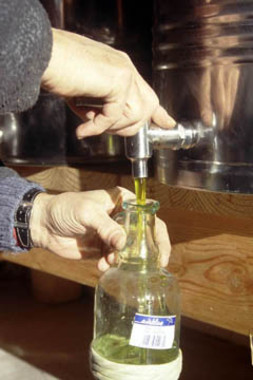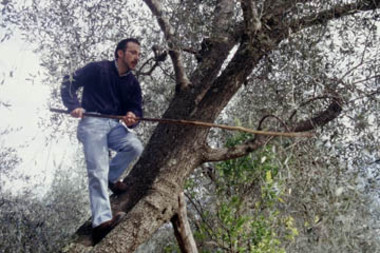Great oil, the traditional way
February 24, 2003 - The Montreal Gazette

Arriving in Liguria from the north, the Apennine Mountains jut up abruptly, bringing transportation to a crawl. When they fall into the Mediterranean on their southern side, it is just as sharp a drop. How someone looked at these mountains and valleys and said “I see countless terraces covered with olive trees” is difficult to imagine.
In contrast with the olive groves in the forever rolling hills of Spain, this is what Ligurians have to work with. Many years later, however, our palates give thanks; Ligurian olive oil is some of Italy’s lightest and finest. Much of the magic lies in the taggiasca olive, the purple-green wonder responsible for creating the oil.
Paired with simple Ligurian cuisine, the taggiasca creates beautiful harmonies, underlining lighter fare such as grilled fish, vegetables, or as part of a vinaigrette or a divine pesto. Creating high-quality olive oil in Liguria is certainly a family affair. To see the November-February harvest in action, Alessandro Anfosso takes me up into the olive groves to meet his father, the baron in the trees.
“Papa! Papa!” he calls out.
Nothing.
We run up the hill looking for the 73-year-old and pass a goatherd and her tiny flock, but no papa. Finally papa appears in a tree, pruning branches and looking as if he’s stepped out of the pages of an Italo Calvino novel.
Davide Anfosso’s hands are like worn leather and his face is wrinkled. He wears burlap pants with a hatchet tucked into his belt. Giant tufts of hair grow from his ears. He floats through the trees with the confidence of a
9-year-old.
This is the man you want harvesting your olives.
“I’ve had an open-air office for 55 years - I can’t complain,” he shouts down. “I’ve never been up in an airplane, just up here.”
 The Ligurian technique of picking olives involves shaking them out of the trees using long sticks. They are caught in nets on the ground, then transported to be washed and processed. Photo by Joe Ray
The Ligurian technique of picking olives involves shaking them out of the trees using long sticks. They are caught in nets on the ground, then transported to be washed and processed. Photo by Joe RayFarther up the hill, we hear a ‘witcha, withcha, witcha’ noise and find more men in the trees doing the bacchiatura with their bastoni, the Ligurian technique of shaking olives out of the trees using long sticks. The olives fall onto nets that cover acres of ground and are scooped by hand into plastic tubs.
To best understand the process of making the oil, visit the nearby Bronda or Sommariva families. Their shops are tiny and bursting with the wonderful smell of the oil and their tiny production area is in plain sight. Bronda, it turns out, sells most of their oil to locals who stop by, shoot the breeze and fill a big plastic jug with oil before they go on their way.
Brothers Andrea and David Bronda, seventh-generation olive-oil producers in the town of Vendone, explain how the oil is created.
Harvested olives are poured into a metal bucket with water swirling through it, getting a high-speed washing before jigging their way down a slotted ramp that removes leftover leaves and stems. The olives roll directly into what Davide simply calls La Macchina, or the mill, for a pummeling of 30 minutes to an hour.
Watching the mill run is perhaps the most typical and recognizable part of the process where two offset granite wheels roll in circles atop a third horizontal wheel, creating a chunky paste. The paste passes into a series of spiraling arms that render it even finer before passing it on to a two-step centrifuge process that separates first the solids then other liquids before yielding the unfiltered chartreuse beauty called “mosta” - the oil.
Between dodging the ever-present three-wheeled Vespa trucks, returning waves to everyone in town like he’s the mayor, and blasting New York, New York on the car stereo, Agostino Sommariva and his sister Mina, the heads of
Sommariva olive oil, reveal a few of the tricks of the trade.
“One of the most important parts of the process is pressing the olives immediately after harvesting them,” explains Mina. “If you let them sit too long (more than a day) the acidity goes up and the taste is no good.”
Not all the producers follow the same process: Anfosso uses the traditional fiscola, a series of circular mats (once cotton, now nylon) that are coated with the milled paste, then stacked on a spindle.
Producers Abbo and Costa dei Rosmarini have gone as far as forsaking the mill for the “frangitore a martelli,” a slightly-bigger-than-a-breadbox machine that crushes a slow stream of olives with a series of tiny hammers.
“It’s a bit less poetic like this,” explains Isabelle Abbo, “but the quality can be better.”
At the old Abbo family mill in Ventimiglia, Isabelle Abbo and her brother Giovanni go over what to look for in the oil. The process is similar to wine tasting and was even the subject of Giovanni’s thesis.
“Compared to wine, it’s a bit harder to explain the quality of oil because it’s a condiment - you always eat it with something else. Luckily, I like to eat,” says Giovanni. “The goal,” he continues, “is to figure out what it goes best with.”
The tasting is divided into three parts: aroma, taste and appearance. Giovanni pours a finger of oil into a blue glass shaped like an inverted apple that he palms to warm the oil. This vaporizes more of the viscous liquid, a key step in the tasting process, as smell, whether the oil is in the glass or in your mouth, accounts for much of your ability to taste.
Giovanni pokes his nose into the glass, which channels the vapour in the right direction and reveals the typical Ligurian smells of cut grass, flowers, artichoke and olive fruit.
He takes a small sip and holds it in his mouth, then with teeth clenched and the tip of his tongue on his palate, he takes in a few sharp breaths of air then breathes out through his nose. What he’s doing is vapourizing the oil in his mouth, revealing more of the oil’s flavour that includes an artichoke flavour, a gentle spiciness, perhaps a taste of almond, and a lingering near-sweet aftertaste.
Ligurian oil tends to be a vibrant near-chartreuse golden yellow or green (steer clear of those with brown tints) and, if unfiltered, cloudiness tends to mean more flavour.
Faults in the processing of oil can also be detected during the tasting.An earthy flavour can mean the olives sat for too long in the nets; a peanuty or old-butter smell can be signs of poor storage or too much sediment.
For the timid taster, the Abbos recommend pouring the oil over a plate of steamed potatoes. Their neutral flavour won’t get in the way and the warmth brings out the oil’s flavours.
If you’re looking for more than potatoes to serve with your Ligurian oil, the rule is keep it simple. Alessandro Anfosso grins like a little boy when he pours it over the grilled fish on his plate. He swears his mother makes desserts with Anfosso oil and even gives his kids a healthy spoonful in the morning. Luisa Petrelli cooks up a 10-minute pasta masterpiece by heating canned diced tomatoes on the stove for a few minutes, cutting the heat and tossing in some salt, pepper, garlic, oregano, some salted olives and a few healthy glugs of oil and basta!
Rosmarini tends to buy all of the olives for the oil they export, and sends them to a nearby production facility that they rent to produce the oil. They make up any lack in technical knowledge by pulling in a hired gun adviser,along with paying dearly for the best possible olives. It’s a more piecemeal process, but the end result is worth the high price of their recent entry into the business.
Making top-quality olive oil in Liguria is a mix of family and tradition, quality and slow modernization.
“Every region in Italy has good oil,” concludes Agostino Sommariva, “and Ligurian oil is known for its sweet, non-overpowering flavor. The problem in Liguria is the parking.”
Where to Buy
Abbo olive oil is available online at http://www.hypergourmet.com
Rosmarino is part of the Fine Food Network, based in Montreal. Call (514) 603-6561.
Bronda olives are available at Williams-Sonoma in Canada.
Other Ligurian olive oils are available in Les Douceurs du Marche Atwater, 138 Atwater Ave., and Milano Fruiterie, 6862 St. Laurent Blvd.
Getting There
Where to stay: Perhaps one of the most interesting places to stay in Liguria, and an excellent base for your travels is in the tiny refurbished medieval village of Colletta di Castelbianco. Prices depend on season and length of stay. Check out http://www.colletta.it, call 011.39.01.31252471 or write .(JavaScript must be enabled to view this email address).
Information: The Liguria Tourism Office’s phone number is 011 39 01 053 0821. Its Web site is http://www.turismo.liguriainrete.it - then click on the British flag.